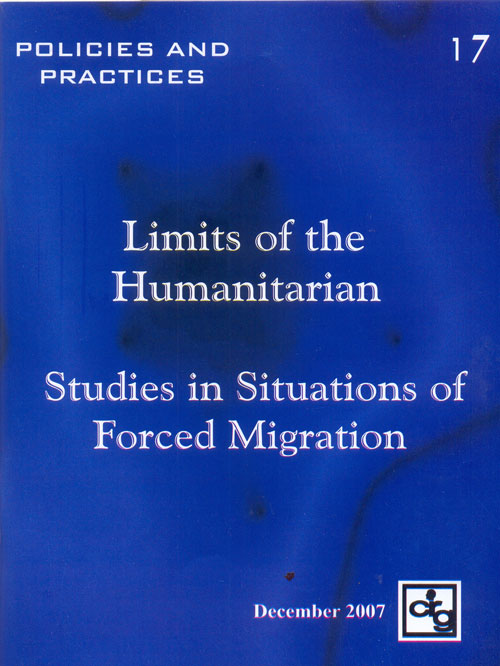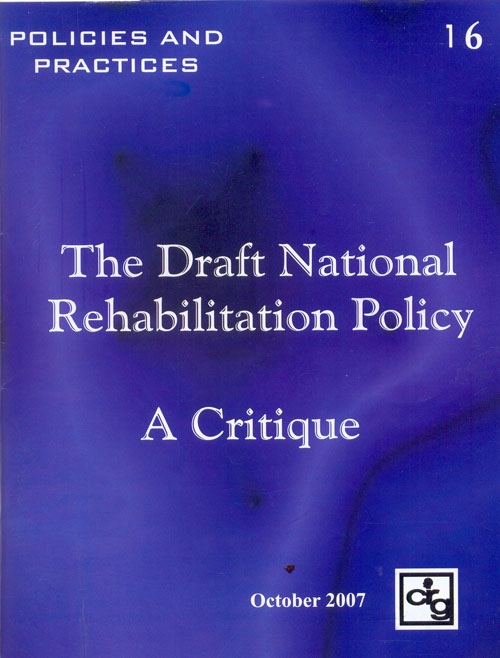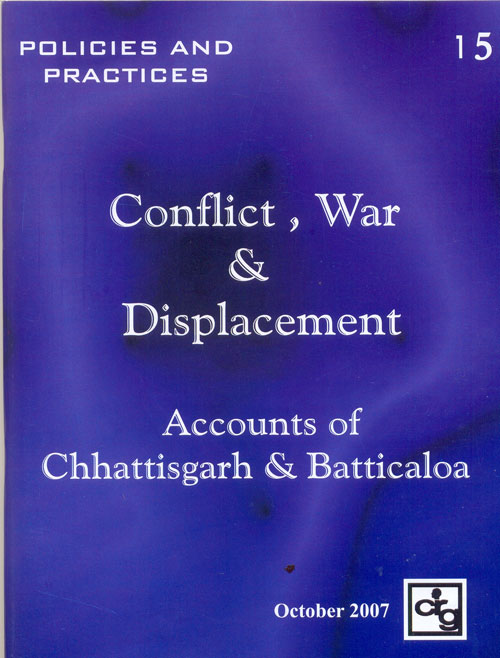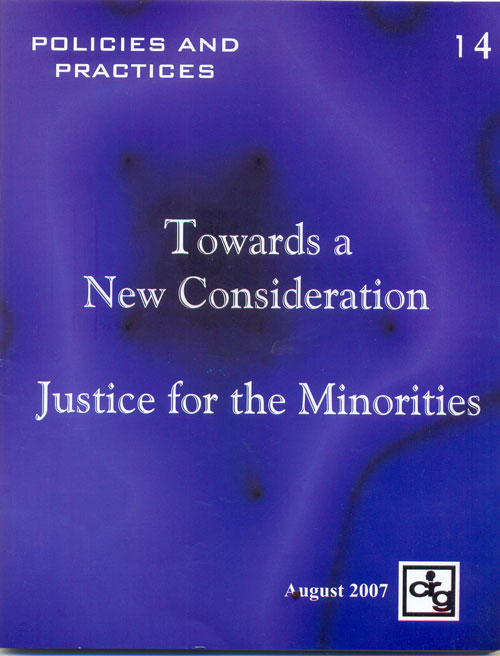|
 |
|
 |
| |
2007 |
 Next Year
Previous Year
Next Year
Previous Year
 |
|
|
| |
|
|
|
| |
Policies
and Practices 17
Limits
of the Humanitarian: Studies in Situations of Forced Migration
While
forced migration is the central theme of the three studies presented here, what
brings them together between the covers is their discussion of the limits of
the humanitarian gaze represented primarily by the national policies followed
towards the victims of forced migration and secondarily through the lens of the
typical cameraperson who shoots them as a stranger. As “forced migration” turns
into a public issue with the beginning of the new millennium - thanks to the
efforts of the UN, other multilateral bodies, and various public forums of the
victims – the humanitarian gaze becomes overwhelming, in the process making the
victim an object of charity and protection. The victim’s transformation into
such an object coincides with a surge of national and international policies
showered on them. In India for instance at least half a dozen draft national
policies of rehabilitation have already been prepared, and a bill to address
the problems faced by the victims of displacement induced by communal violence
is in the pipeline for ratification by the Indian Parliament. While
humanitarian care and protection, as these studies reveal, partly address and
alleviate the sufferings of the victims, they also strengthen the power of the
caregivers including that of the nation-states, the huge corporate
organisations of non-governmental agencies, and the multilateral institutions
working like big companies. Care has truly become a new form of power that
holds out the promise of delivering the victims into safety, security, and
freedom, and reintegrating them into newer and hitherto unknown social bodies.
While in the first two studies the discussion remains implicit, the Kolkata
case shows how the victims turn the gaze on the cameraperson and the lens of the
camera turns into a site of contest between what the stranger constantly seeks
to frame and ‘colonize’ and the way the gaze is turned back by the victims.
Camera as the study reflects can be more than a mere instrument of
colonization: it can serve as an instrument of subversion also. The stranger’s
encounter with the victims finally remains what it is - the ‘with’ as an
indissoluble remainder.
Essays
by
Shiva
K. Dhungana, Priyanca Mathur Velath, Nanda Kishor and Eeva Puumala
|
|

|
| |
|
|
|
| |
Policies
and Practices 16
The
Draft National Rehabilitation Policy: A Critique
The Draft National Rehabilitation
Policy (2006): A Critique is published as part of the 16 Policies and Practices
that CRG brings out regularly. It has two sections; Section I traces the evolution of the
draft and brings it to its present status under the UPA Government. Under it,
The sub-sections i - iii deal with the specificities of NRP 2006. The first sub
section argues that the principle of eminent domain has its legal roots in the
colonial times. The second subsection focuses more on the draft itself and
points out its shortcomings. The third sub section continues with the critique
and raises the larger question of political will – or more accurately the lack
of it that is held responsible for the shortcomings outlined in the second part.
In Section II we have provided a
short critique of the Communal Violence (Prevention, Control and Rehabilitation
of Victims) Bill, 2005. The study then attempts to conclude the combined
critique of the bill and the NRP Policy. Though the bill and the policy are not
on the same platform for being different by nature and their potential
enforceability, we have included it in this study as both the bill and the
policy seek to deal with the question of relief and rehabilitation. More
importantly both the drafts, if studied in a comparative way will enlighten the
reader about the rationality of nation building and rebuilding and the
instrument(s) though which the state makes such attempts according to this
logic.
Essays
by
Walter Fernandes, Priyanca Mathur Velath, Madhuresh Kumar, Ishita Dey, Sanam
Roohi and Samir Kumar Das
|
|

|
| |
|
|
|
| |
Policies
and Practices 15
Conflict,
War & Displacement: Accounts of Chhattisgarh & Batticaloa
The two
studies presented here are based on a unique understanding of the lives of
people displaced due to conflict in Indian subcontinent. Both these studies try
to understand the situation of the camps, internal camp politics and issues of
right to return and its implications.
Subhas Mohapatra in his study
Conflict-Induced Displacement in Chhattisgarh: Analysis and Situation Report
on The Displacement Camps tries to understand the condition of the
internally displaced persons through an analysis of relief the six relief camps
Dornapal, Erabore, Injrem, Konta, Pollampalli and Mariguda. The findings of the
study focus on situation of the displaced within the camps and also on situation
of those displaced outside the camps. One of the interesting dimensions of the
study is how people have been forced to migrate to camps from conflict torn
villages and how these camps are become sites of “state” power.
Chathuri
Jayasooriya in her study The ‘Right to Return’: Commentary on the Return of
the IDPs in Batticaloa, Sri Lanka focuses only on the returns which took
place to Vaharai in East Batticaloa and Vellaveli in West Batticaloa. Batticaloa
is the only Tamil majority district in the Eastern Province of Sri Lanka. Over
the years, it has been the site of multiple displacements, housing a large
number of IDPs on the run for decades, displaced and re-displaced on multiple
accounts. In her study, she examines conduciveness of return sites, options
presented to the returnees, the psycho-social impacts of displacement, gendering
of conflict and post-conflict situations, empowerment of the IDPs and their
participation in decision-making processes and various other dimensions.
Essays
by
Subash Mohapatra and
Chathuri
Jayasooriya
|
|

|
| |
|
|
|
| |
Policies
and Practices 14
Towards
a New Consideration-Justice for the Minorities
It examines the protective strategy of the Indian State with regard to minorities and shows,
how such a strategy of protection quickly transforms into another policy of
governing the people. This issue containing three articles shows in the
process, how situations of marginality produce incipient demands for justice.
Finally it suggests the necessity of a new charter on minority rights. It
emphasises the need for a dialogic and right-based approach as distinct from a
protection based approach.
Essays
by
Samir Kumar Das, Paula Banerjee and Sabyasachi Basu Ray Chaudhury
|
|
 |
| |
|
|
|
| |
Policies
and Practices 13
Weapons
of the Weak-Field Studies on Claims to Social Justice in Bihar and Orissa
In
Globalisation, Patriarchal Development, and the Protesting Voices
in Orissa Amrita M Patel tries to show that since the 1990s, with the
advent of the New Economic Policy, one continuous premise that has been put
forward by the Government is that Orissa needs rapid ‘industrialization’
to mitigate its poverty. Banking on the state’s huge mineral resources
(90% of India's chrome ore and nickle reserves; 70% of bauxite; and 24% of
coal reserves), the government thinks that mining based industries can
alleviate poverty of the state. The mines are now being leased out to
private investment. This understanding has led to a faulty analysis of the
whole situation leading to a skewed process of development in Orissa. As the
majority of the women in Orissa live in rural areas, their lives and
livelihood and living conditions depend on traditional activities like
agriculture, forestry and fishing. Besides wage disparities, there is also
unequal distribution of activities and workload as well as in access to and
control of resources. Women are involved in jobs involving maximum drudgery
such as transplantation but they are deprived of ownership and control of
resources and technical knowledge. Against such a back ground, Orissa has
been the pioneer in many of the social protest movements such as the Balco
protest, Gandhamardan protection movement, Tata movement, Chilika Bacchao
Andolan, Mada Mukti Andolan, Utkal Alumina protest which have been aimed at
the ‘developmental projects’ These movements have been spread in all
parts of the state in Sambalpur, Gopalpur, Kashipur, Banpur etc
In
Gulamiya Ab Hum Nahi Bajeibo: Peoples’ Expressions for Justice in
Jehanabad, Manish K. Jha talks about the the district of Jehanabad which
is an apt example of almost unshakable nexus between feudal peasantry,
political leaders, criminal gangs and police forces. Over the decades the
productivity in the area declined which increased exploitation of landless
labourers through low wages and small share of produce for sharecroppers and
many were also denied rights over gairmazarua (government or public commons)
land and all other common village resources. Gradually the victimised
labourers felt the need of organising themselves and they rallied around
left organisations like Indian Peoples’ front, an erstwhile political
outfit of CPI (ML) Liberation. As the locale of Jehnabad shows such
expressions of violence ironically in the name of securing justice and fight
for dignity exposed the shallowness of state’s institutional justice
system. Willful erosion of state’s institutional structures does not
naturally mean the withering away of the cravings for a just life amongst
people and thus organising new institutions such as the Jan-adalat
(people’s court) around the issues of sexual oppression, low wages and
land issues. The consciousness of social reality and assertion of social
justice undoubtedly have helped people in enhancing their social power, even
when their economic status has remained by and large unchanged. Despite the
fact that the image of Bihar is generally under siege, one cannot refute
that the language of politics as also the power discourse have transformed
significantly in the last two decades.
Essays
by
Amrita M Patel and Manish K. Jha
|
|

|
| |
|
|
|
| |
Policies
and Practices 12
A Status Report on Displacement in Assam & Manipur
While inter-ethnic conflicts have by no means been rare in India’s Northeast, population
displacement induced by such conflicts is sharply on the rise particularly since
the 1980s. Conflicts and violence confined in the past mainly to the armed
groups and the security forces of the state seldom triggered off population
displacement of such scale and magnitude as one notices now. It is important
that we take note of the changing dynamics of conflicts and violence in the
region. Conflicts today have acquired a truly mass character in the sense that
they show an alarming propensity of engulfing an ever-greater number of people
involved in them. In this situation, it is ironic that the two rights of home
and homeland run at cross-purposes. This has its implications for the politics,
ecology and topography of the region. Mixed areas with historically practised
exchanges and transactions between communities are at peril. And, thus for
instance, never before in its history has Manipur been so much divided as it is
now. Internal displacements sparked off by conflicts are a product of many a
hidden partition in the society seldom officially acknowledged. This study on
fifty years of population displacement in Manipur tells us the story of a
society that has hit almost a blind alley with little clue as to how to cross
the divides and negotiate its rapidly changing ethnic landscape. We need to
complement it with many other stories. As various stories marked by these
divides unfold, they reveal a surprisingly similar structure – a structure that
constantly reminds us of how violence once initiated eventually gathers its own
momentum and takes its toll on each one of us – big or small, powerful or
powerless. The essay on Assam prods us to think in terms of formulating an
agenda that takes us beyond the given fault lines. It underlines the need for
dialogues as a means of addressing the issues of rights and justice. We cannot
ignore the fact that the development-induced displacement against this backdrop
of ethnic tensions has complicated the problem related to rights and justice in
India’s Northeast even more.
Essays
by
Monirul Hussain and Pradip Phanjoubam
|
|

|
| |
|
|
|
| |
|
|
|






